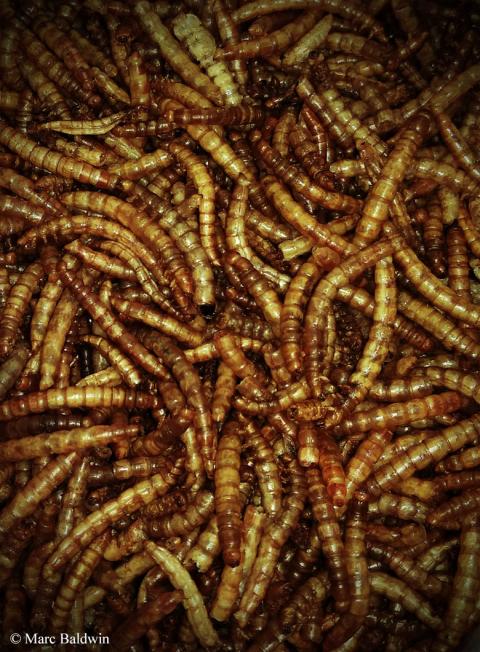European Hedgehog Interaction with Humans - Supplemental Feeding
Outside of the rescue centres caring for sick and injured hedgehogs, the majority of positive human-hedgehog interactions are probably in the form of feeding those that visit private gardens. Owing both to the popularity of keeping hedgehogs as pets and feeding garden wildlife, research and money has gone into developing and commercially producing hedgehog foods. Indeed, commercially produced comestibles were even the subject of a scientific paper when, in an article to the German veterinary journal Tierärztliche Praxis ("Veterinary Practice") in May 1997, E. Landes and colleagues at the Institut für Tierernährung in Hannover assessed the palatability, digestibility and nutritional composition of six commercial hedgehog foods. They found commercial products were generally cereal-based, with some insect and crustacean (prawn) inclusion and some had an unfavourable calcium-to-phosphorous ratio (see below).
Here in the UK it is now possible to purchase several dried and moist hedgehog foods. Some other tried and tested foods to put out for hedgehogs include tinned dog and cat food, dog and cat biscuits, minced beef, peanuts and mealworms (Tenebrio molitor larvae). It should be noted, however, that both peanuts and mealworms have a low calcium-to-phosphorous ratio and eating too many can impair calcium absorption in the gut, leading to thinning of the bones. No doubt many other insects that are commercially sold as food for other pet species, crickets sold as food for snakes and small mammals for example, would be readily accepted. Equally as important as food is a supply of fresh water, particularly when supplying dry foods.

Bread and milk is still a relatively common "treat" left out for hedgehogs and it is readily eaten. Indeed, Anni Rautio and colleagues in Finland found that almost all the 33 stomachs they dissected during their study contained human food; milk, fish and unidentified meat (pet food?) being particularly common. Unfortunately, like many mammals, hedgehogs are hypolactasic. In other words, they're lactose intolerant -- they lack the lactase enzyme required to metabolise the lactose (sugar) in milk. Indeed, Susanne Struck, in her thesis on hedgehog nutrition, published in 1995, reported that suckling hoglets do not have any detectable lactase activity and this explains why analysis of hedgehog milk reveals only trace amounts of lactose.
I am not aware that the specifics of lactose intolerance have been studied in hedgehogs, but in humans without lactase, the lactose remains undigested in the intestine; gut bacteria can adapt to fermenting this sugar, producing gas. This gas builds up to cause, among other conditions, stomach cramps and diarrhoea; greenish diarrhoea has been documented in captive individuals fed on a diet of cow's milk and bread. The short answer to the problem is: do not give hedgehogs bread and milk. Rescue centres that need to provide milk to hoglets opt either for a milk substitute or goat's milk, the lower lactose of the latter seems to cause significantly fewer digestive problems in hedgehogs.

Supplemental feeding has been widely cited as changing the natural diet of wildlife as well as altering their normal foraging behaviour and/or patterns, causing them to lose their fear of humans and possibly even become dependent on the food source for survival. Furthermore, provision of extra food could potentially permit an increase in population numbers. Some of these arguments are justified, other less so (see QA). In the case of hedgehogs, mot studies suggest that providing suitable supplemental food doesn't seem to have any discernible impact on natural foraging behaviour; it's used as a supplement to, not replacement for, their natural diet. While food sources may attract hedgehogs from different areas, the tracking data of Pat Morris and Nigel Reeve show that hogs don't move immediately for supplemental food, nor appear to form any sort of dependency upon it. Les Stocker reaffirmed this in The Complete Hedgehog. Preliminary findings by Dawn Scott and her team at the University of Brighton suggests, however, supplemental food may now be beginning to change the order in which hogs visit gardens - more tracking data are needed to confirm these observations. Regardless, the effect on local population size remains unclear, as is whether concentrated sources of food perpetuate more fighting among visitors.
In a 1994 paper to the journal Ecography, Marcelo Cassini and John Krebs at Oxford University presented data on the behavioural responses of hedgehogs to supplemental food. The data show that areas of the habitat to which food was added experienced an increase in hedgehog density, with the animals learning to associate visual cues with presence of food and learning where the food could be found. Overall, the addition of food did not, however, significantly change the average number of hedgehogs in the area. In other words, the food attracted animals from other areas and thus the population density increased, but these were visitors and not residents.
Cassini and Krebs suggest that social factors may have placed an upper limit on the population size, despite additional food. Nonetheless, there are several studies suggesting hedgehog density in urban areas can be significantly higher than that in surrounding arable or pastureland and this is often considered to be a response to additional food. Indeed, in the 2011 paper to Landscape and Urban Planning, Pauline Hubert and her team report that, on their study site in the Ardennes region of northern France, adult hedgehog abundance was predicted by the availability of earthworms and pet food left out by residents. Interestingly, however, the reproductive rate in the urban areas was not higher than that in surrounding rural land.